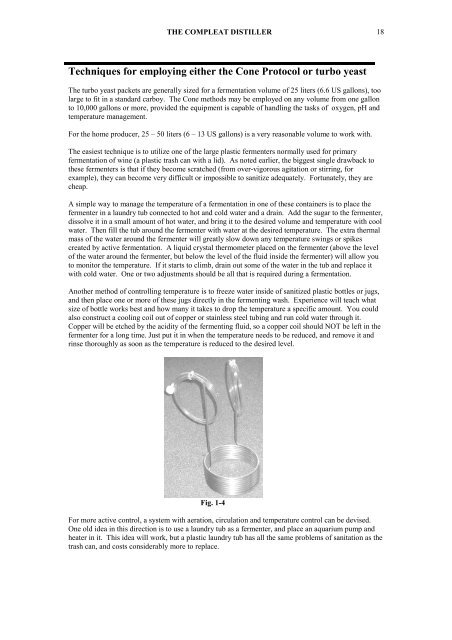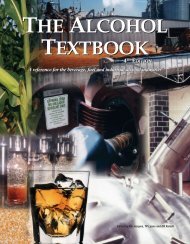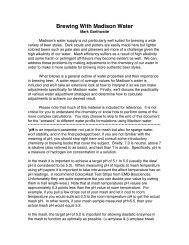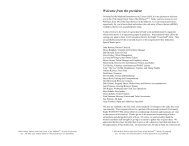The Compleat Distiller
The Compleat Distiller
The Compleat Distiller
Create successful ePaper yourself
Turn your PDF publications into a flip-book with our unique Google optimized e-Paper software.
THE COMPLEAT DISTILLER 18<br />
Techniques for employing either the Cone Protocol or turbo yeast<br />
<strong>The</strong> turbo yeast packets are generally sized for a fermentation volume of 25 liters (6.6 US gallons), too<br />
large to fit in a standard carboy. <strong>The</strong> Cone methods may be employed on any volume from one gallon<br />
to 10,000 gallons or more, provided the equipment is capable of handling the tasks of oxygen, pH and<br />
temperature management.<br />
For the home producer, 25 – 50 liters (6 – 13 US gallons) is a very reasonable volume to work with.<br />
<strong>The</strong> easiest technique is to utilize one of the large plastic fermenters normally used for primary<br />
fermentation of wine (a plastic trash can with a lid). As noted earlier, the biggest single drawback to<br />
these fermenters is that if they become scratched (from over-vigorous agitation or stirring, for<br />
example), they can become very difficult or impossible to sanitize adequately. Fortunately, they are<br />
cheap.<br />
A simple way to manage the temperature of a fermentation in one of these containers is to place the<br />
fermenter in a laundry tub connected to hot and cold water and a drain. Add the sugar to the fermenter,<br />
dissolve it in a small amount of hot water, and bring it to the desired volume and temperature with cool<br />
water. <strong>The</strong>n fill the tub around the fermenter with water at the desired temperature. <strong>The</strong> extra thermal<br />
mass of the water around the fermenter will greatly slow down any temperature swings or spikes<br />
created by active fermentation. A liquid crystal thermometer placed on the fermenter (above the level<br />
of the water around the fermenter, but below the level of the fluid inside the fermenter) will allow you<br />
to monitor the temperature. If it starts to climb, drain out some of the water in the tub and replace it<br />
with cold water. One or two adjustments should be all that is required during a fermentation.<br />
Another method of controlling temperature is to freeze water inside of sanitized plastic bottles or jugs,<br />
and then place one or more of these jugs directly in the fermenting wash. Experience will teach what<br />
size of bottle works best and how many it takes to drop the temperature a specific amount. You could<br />
also construct a cooling coil out of copper or stainless steel tubing and run cold water through it.<br />
Copper will be etched by the acidity of the fermenting fluid, so a copper coil should NOT be left in the<br />
fermenter for a long time. Just put it in when the temperature needs to be reduced, and remove it and<br />
rinse thoroughly as soon as the temperature is reduced to the desired level.<br />
Fig. 1-4<br />
For more active control, a system with aeration, circulation and temperature control can be devised.<br />
One old idea in this direction is to use a laundry tub as a fermenter, and place an aquarium pump and<br />
heater in it. This idea will work, but a plastic laundry tub has all the same problems of sanitation as the<br />
trash can, and costs considerably more to replace.









